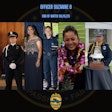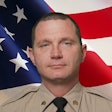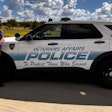A part of law enforcement iconography since the early 19th century, striking instruments such as the baton have not been without their share of criticism both in and out of police stations.
Critics see impact weapons as cylindrical conveyers of carnage, holding primal appeal to the "batter up" sensibilities of abusive authorities. Defenders say that they have historically filled a use-of-force gap between fisticuffs and firearms.
Some experts say that the use of striking weapons is contributing to their obsolescence. Nothing looks worse on video than footage of a cop hitting someone with a club, even if it is justified. Such images and the lawsuits that they have spawned have hastened research and development of such incapacitators as chemical agents and TASERs.
Of course, TASERs and OC have their critics as well. And some people characterize their use as "brutality." But if you asked most Americans to draw a portrait of "police brutality," odds are it would show a cop with a baton or some other "club." The images of the Rodney King video and the accounts of the Malice Green case have burned the image of cops using impact weapons into the minds of the public.
And as with TASERs, OC, handguns, and every other weapon used by law enforcement, batons have been the target of calls for bans on their use. But unlike most other police weapons, there are cops that wouldn't miss them.
A Difficult Carry
East Coast-based use-of-force instructor Dave Young says that he isn't surprised at the vilification of the baton.
"Society wants to blame the use of a product or a weapon rather than the training of our own personnel [for these incidents]," Young says.
But despite such controversy involving the use of striking weapons, Young says they still have a place on your belt and in your hand when things get tense. "Batons are probably one of the most valuable tools a police officer can have on his belt. They don't malfunction. They provide you with greater distance from the threat in lieu of having to use deadlier force. You will never hit a person harder with your hand than you will with your baton. The baton is the best equalizer, the best low technology weapon on a law enforcement officer's belt," Young says without reservation.
Young's defense of the baton focuses on its effectiveness. Other trainers say that it can be very effective, but they add that many of today's officers aren't skilled with it and would prefer not to carry it for a variety of reasons, including comfort.
"I've always found the side-handle baton a difficult carry. And I'm not alone," says Texas-based use-of-force instructor and retired officer Louis Marquez.
Marquez and others say that batons are becoming obsolete because officers don't want to carry them, and they are often under their car seats when they need them most. The reasons officers have offered up for abandoning the baton and its ilk include:
- The noise they make on location approaches
- They come loose during foot pursuits and fights
- Their use often requires more justification than other use-of-force options
That last concern is so strong in the minds of some officers that one officer contacted for this article says he prefers to carry an ASP "because it is much easier to forget," making it less likely that he "will actually remember to use it and find himself sitting in some federal prison for violating a suspect's civil rights."
[PAGEBREAK]
AWOL from the Belt
Unfortunately, such disregard for batons has resulted in situations where other weapons of last resort, such as flashlights, have been used.
The use of a flashlight as a club in one highly publicized incident spurred the Los Angeles Police Department to ban flashlight strikes and even redesign its officers' flashlights. One might reasonably ask if LAPD's posture on flashlights would have taken so drastic a change had the involved officer used a baton instead.
But the fact remains that the baton hasn't just been absent from certain high-profile videos; it has gone AWOL from many officers' belts, a reality that concerns trainers at some of the nation's leading law enforcement agencies.
Sgt. Brian Muller of the Los Angeles Sheriff's Department looked into the matter and subsequently wrote a revised policy on batons for the department.
"A decade ago, the department's policy stated that batons should be 'readily available,'" says Muller. "But a lot of deputies simply began leaving their batons in their war bags in the trunk of their vehicles, largely because of King-related fallout. Then when they needed them, they didn't have them. We removed that discretion, and now policy mandates that personnel—with certain exceptions, such as plainclothes investigators—shall carry their batons with them."
Dinosaur Fallacy
While some agencies still retain rigid policies about baton carrying, others are actually moving away from batons.
It's a reality that finds Marquez less than optimistic about the role side-handle batons like the PR-24 and even telescoping batons will play in the future of law enforcement. And he see that as a problem. "There are still failures of TASERs, which means that you're still going to have to use the baton," Marquez says. But he also believes that improved TASERs and other high-tech weapons will soon obviate the need for batons.
David A. Rose, a consultant with the Law Enforcement Physical Skills Training & Consulting Co., doesn't see that day coming. A use-of-force expert and legal consultant, Rose believes that striking instruments will always have a place in the law enforcement arsenal.
"The idea that batons are going the way of the dinosaur is a fallacy," declares Rose. "Because multiple cases show that at some point you have to go hands on. One guarantee about technology—whether it's law enforcement, military, or civilian, as you know working with computers or cell phones—when you really need it, it fails. Mechanical devices aren't affected by batteries going weak, barbs in TASERs being the wrong distance apart, or wires breaking."
And Rose brings up another concern.
"If you have somebody who's an excited delirium suspect, and he's playing Tyrannosaurus Rex and nothing seems to be stopping him, impact force may be the only thing that you have because maybe deadly force isn't available to you based on the totality of the circumstances. Maybe impact force won't stop him, but it might break bones so that he can't stand any more or grab your other use-of-force options, or choke you, or poke your eyes out."
[PAGEBREAK]
Training Gap
One thing the experts contacted for this article agree upon is that a lack of training and weapons proficiency has diminished the ability of officers to effectively wield impact weapons.
Indeed, now 18 years following the King incident, many use-of-force experts see the cause of that tragedy to be less a case of police abuse than an indictment of Officer William Powell's proficiency with the weapon. It's a problem we may see again, and you can bet that someone will be there to capture it on video.
"In academies, the actual use-of-force training (shooting, batons, pepper spray, etc.) usually gets shortchanged," notes Marquez. "So with the PR there's a lack of development of the high level of expertise that is necessary if you're going to carry it. For both guys and girls, that's a lot of baton that they don't want to mess with. So my recommendation is to go with an expandable baton like a Monadnock or an ASP."
Regardless of the striking weapon chosen, improper training may result in injuries to personnel, as well as civil damages. In the wake of one baton training session gone south, Brawley, Calif., ended up paying a medically retired officer $2.35 million in damages.
Planned Obsolescence
But perhaps the biggest threat to striking weapons is a growing perception that TASERs have mitigated their need, perhaps even rendered them obsolete to the minds of some.
Barry Brodd teaches defensive tactics for police, Army, Park Service rangers, regional parks, probation officers, the whole gamut of people. Brodd has noticed an over-reliance on the TASER and cites instances wherein the TASER has been deployed under less than ideal circumstances such as when a suspect is within a couple of feet of an officer and the probes can't spread far enough to create a good circuit.
"That eliminates any effective backup plan if the TASER is ineffective or if the darts don't hit the intended target," Brodd observes. "By then the suspect is right on top of you and the TASER is not effective in close quarters. Of course, it can be used as a contact stun device, but if this fails and the suspect gains control of the TASER, then what?"
Brodd says the answer to his concern is to prevent the situation in the first place using teamwork.
"We train if one officer is deploying a TASER, then the other officer is ready with lethal force. Or if the TASER is ineffective and the situation hasn't escalated to where lethal force would be justified, the second officer would use the baton. Especially with the expanding batons, the motion of expanding it is almost a type of visual escalation to let somebody know, 'Oh, don't hit me with that thing.'"
Marquez agrees that a telescoping baton can be a powerful persuader.
"Being an ASP trainer, I'm going to promote their products somewhat. I think the ASP 26-inch baton is a good tool. If you look at actual kinetic energy the batons deliver, the expandable batons deliver more kinetic energy than a PR; the PR is more a blunt type of baton. It takes a little more talent, a little more skill to use the PR properly, especially to use the short end of it."
Marquez says the argument over batons really has very little to do with their utility and more with administrative and public sentiment against the weapon.
[PAGEBREAK]
Great Tools
Young says he understands that some administrators are not fond of impact weapons. But he believes that whatever criticisms are leveled at batons, they will continue to be a necessary part of law enforcement's arsenal. Young cites five important roles that batons serve:
- They serve as a positive and professional visual deterrent.
- They allow officers to strike harmoniously with greater knock down power.
- They can be used as a restraint weapon.
- They easily transition between blocking, striking, and restraining.
- They allow for transition from a non-lethal scenario to a lethal scenario.
Brodd appreciates other areas where he finds striking weapons uniquely capable of fulfilling several missions. He cites crowd control situations as a prime example.
"Batons are great tools. In bar fights, batons can be used to strike multiple subjects. The TASER is limited to the life of the battery, how many air cartridges you're carrying, taking the time to load those cartridges if the initial cartridge was effective and is no longer effective, etc."
Rose agrees that impact weapons definitely still have a role in contemporary law enforcement. "There's always going to be time for impact force," he says. "Look at your mixed martial arts competitions. At first, we thought we better learn how to grapple because we might get choked out in an arm bar. Once you realize that you can kick a person off you, you can defeat that person. The thing that is winning most of those competitions now is impact force. So batons are always going to be a necessity."
Rose ultimately sees the problem as being one of the right tool for the right job.
"The question is what baton are you going to want to carry and what intermediate force option are you going to use? If you're working a plainclothes or undercover assignment, you don't want to carry something so obviously law enforcement related. But you can always carry some small impact device, such as a yawara stick or a mini-flashlight or something that can be used as an impact device. So, in my mind, there's always going to be a need for impact devices in law enforcement.
"The challenge will be to educate law enforcement management so they understand that. We also need to educate judges, lawyers, and the media so they understand the effectiveness of it and that it's not some terrible force option that should be gone by the wayside because we've progressed beyond the need for that type of force."
Hopefully, with a more universal understanding of impact weapons, the need for them, and the necessary training to use them, there'll be a greater willingness for officers to use them when necessary—and for administrators to back their play.
For ultimately, as Marquez notes, "No matter what weapon you choose—TASER, pepper spray, baton—you should grab it and be as aggressive as hell."














